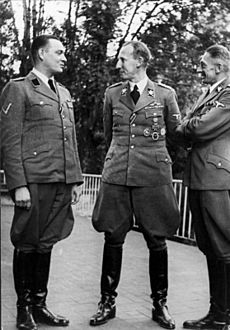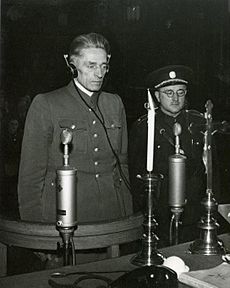Karl Hermann Frank facts for kids
Karl Hermann Frank (born January 24, 1898 – died May 22, 1946) was a powerful German Nazi official from the Sudetenland region. He played a key role in the area known as the Protectorate of Bohemia and Moravia before and during World War II. Frank rose to a high rank in the SS, which was a major Nazi organization. He was in charge of the Nazi police in the protectorate, including the Gestapo (secret police). After the war, Frank was found guilty of war crimes and was executed by hanging for his part in the destruction of the Czech villages of Lidice and Ležáky.
Quick facts for kids
Karl Hermann Frank
|
|
|---|---|

(c. 1941/42)
|
|
| Born |
Karl Hermann Frank
24 January 1898 |
| Died | 22 May 1946 (aged 48) Pankrác Prison, Prague, Czechoslovakia
|
| Cause of death | Execution by hanging |
| Resting place | Ďáblice Cemetery, Prague, Czechoslovakia |
| Criminal status | Deceased |
| Conviction(s) | War crimes |
| Criminal penalty | Death by hanging |
| Minister of State for Bohemia and Moravia | |
| In office 20 August 1943 – 8 May 1945 |
|
| President | Adolf Hitler (as Führer) |
| Chancellor | Adolf Hitler |
| Personal details | |
| Political party | Nazi Party |
| SS career | |
| Allegiance | |
| Rank | Obergruppenführer |
| Commands held | Higher SS and Police Leader for Protectorate of Bohemia and Moravia |
| Awards | War Merit Cross with Swords, 2nd and 1st Class |
Contents
Early Life and Political Beginnings
Karl Hermann Frank was born in Karlsbad, Bohemia, which was then part of Austria-Hungary. Today, this city is called Karlovy Vary in the Czech Republic. His father taught him about strong nationalist ideas, which meant believing his own nation was superior.
Frank tried to join the army during World War I, but he was not accepted because he was blind in his right eye. He studied law for a year at the German-speaking Charles University in Prague and worked as a tutor.
Frank strongly believed that the Sudetenland, a region with many German speakers, should become part of Germany. By 1923, he joined the German National Socialist Workers' Party (DNSAP), a group similar to the Nazi Party in Germany. He helped start several DNSAP branches in Bohemia and Silesia. In 1925, Frank opened a bookstore that sold books about National Socialism.
In 1933, Frank helped create the Sudeten-German Homeland Front, which later became the Sudeten German Party (SdP) in 1935. He worked in the party's public relations and propaganda department, spreading their messages.
By 1935, Frank became the deputy leader of the SdP and was elected to the Czechoslovak Parliament. He represented the most extreme Nazi supporters within the SdP. When the Sudetenland became part of Germany in October 1938, Frank was made Deputy Gauleiter (a regional Nazi leader). He officially joined the Nazi Party and the SS on November 1, 1938.
Role During World War II
In 1939, Frank was promoted in the SS and became the Secretary of State for the Reich Protectorate of Bohemia and Moravia. This area was under Nazi control. He was also named the top SS and Police Leader for the protectorate, making him the highest-ranking SS officer there. Even though he was officially under another leader, Frank had a lot of power. He controlled all Nazi police groups in the protectorate, including the Gestapo (secret police), the SD (intelligence service), and the Kripo (criminal police).
As Secretary of State and police chief, Frank was very harsh towards Czech people who opposed the Nazis. He pushed for the arrest of the Prime Minister of Bohemia and Moravia, Alois Eliáš. These actions were different from the "softer approach" of the Reich Protector, Konstantin von Neurath, who tried to reduce anti-German resistance. Frank was unhappy with Neurath's methods and secretly worked to make him look bad.
Hitler decided to take a tougher approach in Bohemia and Moravia, which Frank hoped would benefit him. In September 1941, Hitler removed Neurath from his active duties. Frank hoped to become the new leader, but Hitler chose Reinhard Heydrich instead. Heydrich was given the job of enforcing Nazi policies, fighting resistance, and ensuring that Czech factories kept producing motors and weapons for the German war effort.
Frank and Heydrich worked well together because they were both ambitious and brutal. They started a period of terror in the protectorate. They arrested and killed many people who opposed the Nazi regime. They also sped up the deportation of Jewish people to concentration camps. Heydrich reported that thousands of people were arrested and hundreds were executed by February 1942.
The Destruction of Lidice
In 1942, Heydrich was assassinated. Once again, Frank was not chosen to be the main leader; Kurt Daluege was picked instead. Daluege and Frank played a major role in the destruction of the Czech villages of Lidice and Ležáky. This was done as revenge for Heydrich's death.
Frank ordered the destruction of Lidice and Ležáky. The people of these villages faced terrible consequences, with many being killed or sent to concentration camps. Some children were taken to Germany to be raised by SS families, while others were murdered.

In June 1943, Frank was promoted again in the SS and became a General of Police in Prague. He also became a General in the Waffen-SS, which was the combat branch of the SS. Under Daluege, Frank continued to gain more power. By August 1943, when Wilhelm Frick was appointed Reich Protector, Frank was the most powerful official in Bohemia and Moravia. In August 1943, he was made Minister of State for Bohemia and Moravia.
Fighting Resistance Groups
In 1944, Frank personally led efforts to fight against resistance groups in Moravia. These groups were trying to disrupt the Nazi control. Even though 13,000 soldiers were sent and many civilians suspected of helping the resistance were killed, the Germans could not completely defeat the main resistance group. They wrongly thought the threat was gone.
Trial and Execution
Karl Hermann Frank was arrested by American soldiers on May 9, 1945. He was sent to Prague, Czechoslovakia, where he was put on trial in 1946. He was found guilty of war crimes and for his role in the destruction of Lidice and Ležáky. Frank was sentenced to death.
He was hanged on May 22, 1946, in the courtyard of Pankrác Prison in Prague. About 5,000 people watched the execution. He was buried in an unmarked grave at Prague's Ďáblice cemetery.
Family Life
Frank was married two times. His first marriage was to Anna Müller in January 1925. They had two sons, Harald and Gerhard. They divorced in 1940.
In April 1940, Frank married Karola Blaschek, who was a doctor. They had three children together: two daughters, Edda and Holle-Sigrid, and a son, Wolf-Dietrich.
|
See also
 In Spanish: Karl Hermann Frank para niños
In Spanish: Karl Hermann Frank para niños




